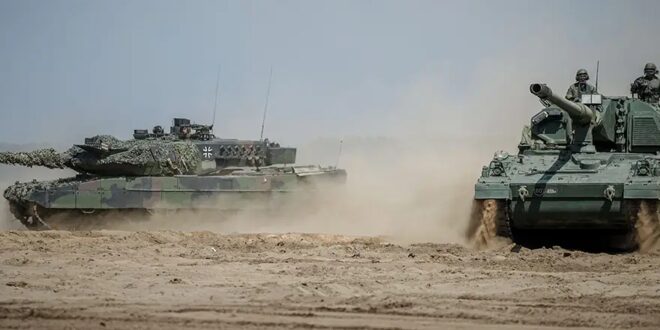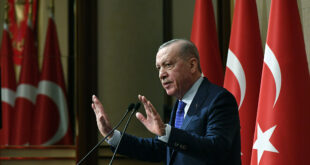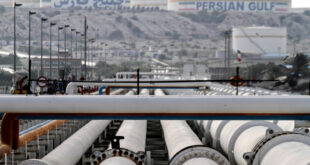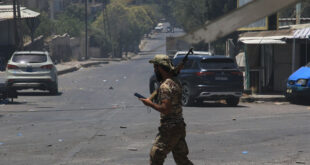NATO’s European members must ramp up investment in ammunition production and focus military training and force structures against key mission sets to credibly deter Russia from exploiting a clash between the US and China in the late 2020s as an opportunity to break Article 5 in Europe.
Throughout 2023, the UK and most NATO allies have been understandably preoccupied with the need to support Ukraine, tackling a range of economic and social challenges, and most recently the sudden explosion of violence in the Middle East. However, the number of acute short-term challenges has distracted political and public attention away from the rising danger of an even more serious conflict in the coming years. Put simply, Russia has now transitioned its economy onto a war footing; US production is not sufficient to replenish its own stockpiles and fulfil Ukraine’s needs; and European countries are trying to manage an increasingly dangerous situation from an unsustainable peacetime defence and industrial posture. This would not be such a serious risk were it not for the fact that the US military is increasingly facing a threat that it cannot overmatch from Chinese forces in the Indo-Pacific. NATO is currently heavily dependent on the US in a wide range of key areas – most notably the ability to roll back Russian ground-based air defences from the air, as well as ammunition resupply, tanker aircraft, command and control and satellite capabilities. In the event of a clash with China in the Indo-Pacific that removes the capacity for large-scale US military reinforcement and support elsewhere, Europe will be left vulnerable to concurrent military aggression by Russia.
For much of the year, Russian forces in Ukraine have been suffering from significant shortages of vehicles, weapons and above all ammunition. However, from a low point in the spring, Russia’s military supply situation has been steadily improving. Its factories are standardising around fewer types of tanks, artillery howitzers and UAVs, resulting in steadily rising production figures. From around 40 long-range missiles per month at the start of the invasion, Russia is now producing more than 100 per month. Artillery ammunition production has almost doubled, and has recently been supplemented by over 1 million shells and hundreds of howitzers from North Korea. Factories have also been set up in Iran to add resilience and additional capacity to Russia’s rearmament drive after the vast losses in materiel and ammunition expenditure of the past 18 months of war.
Russia is settling down for a long war, aiming to grind down Ukraine and exhaust the capacity and will of its Western supporters to supply the vehicles, ammunition and weapons it needs to keep fighting successfully. Despite the huge expenditure this year, the Russian government has announced plans for a 68% increase in defence spending, to around 6.5% of GDP, next year. This will likely prove disastrous for the Russian economy in the very long term. However, those hoping that Russia’s current effort is unsustainable in the short term are likely to be disappointed; it is worth noting that for much of the Cold War, Soviet spending on defence was far higher than this – reaching 21% of GDP by 1985 – and still took decades to arguably bring about the collapse of the USSR. The Kremlin can leverage a formidable coercive information and security apparatus to maintain tight control over any forms of public or political dissent. What little disagreement is visible in Russian political and media circles is largely over how rather than whether to continue the war, with many critics calling for greater escalation or even direct conflict with NATO.
Meanwhile, Europe has failed to make the necessary investments in increased industrial production capacity and defence spending. With the notable exception of Poland, many national commitments to significant additional defence spending have either not yet materialised or are not slated to take effect for several years. The most obvious example is Germany, which shortly after the Russian invasion made a public commitment to spend 2% of GDP on defence by 2024, in addition to a one-off €100 billion investment in revitalising Bundeswehr capabilities. However, only €1.5 billion from the fund had actually been spent by mid-2023, and the defence budget as a whole actually decreased slightly compared to 2022. The UK Defence plan following the Defence Command Paper refresh is already £16.9 billion short of projected planned expenditure over the coming 10 years. Even so, most of the one-off £5 billion boost granted in 2023 was allocated to long-term nuclear submarine and weapons programmes, with only £1.9 billion of it going towards munitions resupply and purchases for Ukraine over two years. The European Defence Agency’s multinational 155mm artillery procurement programme is a solid plan along the required lines, but has been glacially slow to set up compared with the pace at which Ukrainian requirements are outstripping supply capacity. The EDA programme is also still far from sufficient at its current scale to put Ukraine’s war effort on a sustainable footing for the immediately foreseeable future, let alone replenish Europe’s own defence stockpiles, which have been badly depleted.
Despite growing political frustration in many Western countries at the rising costs and lack of decisive progress, there is no easy way out of this war. In post-Cold War counterinsurgency conflicts, Western expeditionary campaigns ultimately ended when a political decision was made in Washington and other capitals to make some form of messy compromise in exchange for a sufficient ‘peace’ to withdraw. This is not possible with Russian aggression in Ukraine. Talk of Ukraine ‘having to enter negotiations’ is dangerously misguided and naïve because it ignores the fact that Russian aims have hardened, but not changed. The Kremlin’s will to grind on can be seen in its clear preparations for a long war and continued offensive action despite suffering several hundred thousand soldiers killed or seriously wounded and more than 2,500 tanks visually confirmed destroyed or captured. This is not the behaviour of a regime that will accept any lasting end to its offensive war of choice if Western governments withhold military support to force Kyiv into making concessions for a negotiated ceasefire. In fact, such a betrayal of Ukraine would have quite the opposite effect, encouraging Putin’s regime to continue to fight in the belief of eventual victory. It would also send an incredibly dangerous message to both Russia and China about the West’s lack of will to fight, making it far harder to deter future aggression.
The only way to end the war is to convince Russia that its prospects for military success will get worse over time, rather than betterIf Ukraine is forced to negotiate a ceasefire, Russia would be in a strong position to demand retreats from key positions and the removal of Kyiv’s remaining military initiative as baseline concessions. Such a process would also fracture Western political unity – which has largely held up to this point – and break all trust between Ukraine and its Western partners, since it could only be forced by withholding desperately needed support. Russia would then most likely spend three to six months reorganising its currently weak logistics, training and force dispositions, and then restart offensive operations from a much stronger position. This was done repeatedly in Syria, where Russia and the Assad regime used ceasefire agreements to freeze the front when they needed an operational pause, and then relaunched offensives where and when it suited them best. Russia also reneged on the Russia–Chechnya Peace Treaty of 1997, signed following the stalemate of the First Chechen War, by reinvading Chechnya in 1999 with much better prepared forces and conquering the country in a brutal campaign that involved almost completely destroying the capital city of Grozny.
There are no concessions the West could force Kyiv to offer, or indeed offer itself, that are more valuable to the Kremlin than defeating Ukraine through its current strategy of resourcing a long war to exhaust Western support and grind down resistance by 2025 or 2026. States do not stop fighting when they think that they can win wars, especially after taking hundreds of thousands of casualties and seeing their previous aura of military power badly damaged internationally by initial poor performance. The only way to end the war is to convince Russia that its prospects for military success will get worse over time, rather than better. This requires investing in the large-scale defence industrial production needed to make Ukraine’s slow offensive progress sustainable. At that point, the Kremlin would have a strong incentive to negotiate a settlement that might conceivably hold, on something approaching acceptable terms for Ukraine.
Russia is set on a course that will see its production of weapons, ammunition and new formations increase significantly over the coming 2–3 years. Depending on how successfully Western governments sustain the supplies that Ukraine needs to keep fighting effectively, this will either make future Ukrainian advances harder to achieve or potentially result in serious reverses to gains made so far. Either way, without major increases in European defence production and a focus on reorganising and training militaries to credibly roll back any future Russian aggression against Alliance territory, Russia will regenerate a capacity to directly threaten NATO faster than most political or even military planners appear to realise.
Putin has repeatedly shown himself to be a strategic opportunist who will take huge military risks if he believes there is a quick and easy win to be had. The invasion of Ukraine in 2022 was itself predicated on the false assumption that Russia could quickly decapitate the Ukrainian government and impose a puppet state without major fighting. NATO must be capable of deterring Russian military aggression that might seek to take advantage of any perceived opportunity to seize symbolic areas of Alliance territory and challenge Article 5 without effective military recourse in the coming years.
Unfortunately, the Chinese military is growing faster and increasing its capabilities more quickly than most thought possible even five years ago. Developments in very long-range anti-ship and anti-tanker/AWACS aircraft missile systems are particularly problematic for key US military capabilities across the vast distances of the Indo-Pacific. Furthermore, many of the US technical answers to some of these problems – such as the Next Generation Air Dominance fighter, Collaborative Combat Aircraft and the new B-21 Raider bomber – will not be available until 2029 or 2030 at a useful scale. The upshot is that the maximum period of risk of the Chinese military attempting to blockade or invade Taiwan or key disputed territories in the South or East China Seas is likely to be 2026–2028. Very problematic Chinese capabilities will be largely mature and fielded, but many of the US answers will not be ready yet. In the event of a dangerous standoff or an actual military conflict in the Indo-Pacific during this period, therefore, the US will be heavily stretched to meet its own commitments and Allied needs in that theatre. It is likely that EUCOM and CENTCOM would have to transfer assets to INDOPACOM in such a scenario, and Europe certainly could not count on rapid reinforcement at scale in the event of a concurrent Russian attack on NATO territory.
The costs of successfully deterring a well armed and amoral adversary pale in comparison to the unimaginable costs of even a successful defensive war once it has begunAny analysis attempting to argue that the military threat from either China in the Indo-Pacific or from Russia in Europe should be prioritised as the more likely misses a fundamental point. China has a strong interest in supporting Russia to ensure it remains a serious military threat in Europe that splits US and Western attention. More importantly, the only likely scenario in which Russia might directly attack a European NATO country is during a concurrent standoff or actual conflict that leaves US forces largely fixed in the Indo-Pacific. In the event of such a military confrontation with China in the mid-to-late 2020s, Russia will have a strong incentive to take a once-in-a-lifetime opportunity to break NATO while the US cannot reinforce Europe effectively. By 2026–2028, Russia’s industry will have been at full-scale military production for years, allowing it to rebuild its increasingly battle-hardened forces.
To deter this concurrent threat, European countries – including the UK – must urgently invest in significantly increasing production capacity for the artillery ammunition, spare parts and air defence missiles required to keep Ukraine in the fight while also refilling their own dangerously depleted stockpiles. European air forces, in particular, must also rapidly procure specialised weapons and dedicate serious aircrew training time and focus to developing high-end suppression and destruction of enemy air defences (SEAD/DEAD) capabilities. Currently these reside almost exclusively among US air arms. The credible capacity to roll back Russian conventional forces in Europe relies on achieving air superiority, since NATO’s European powers lack the recruitment capacity or funding to field the scale and quality of ground forces and land-based firepower needed to beat Russia without it. To avoid being extremely vulnerable when or if US rapid reinforcement is unlikely, European air forces must be able to collectively destroy the Russian SAM systems that currently would make air superiority over contested Alliance territory impossible to achieve without a major US SEAD/DEAD campaign.
Investing at scale in munitions and weapons production will require real political leadership, not least the courage and eloquence to explain to publics unused to genuine military threats why such investment is necessary at a time when so many other public services are desperately short of money. However, Ukraine illustrates vividly that the costs of successfully deterring a well armed and amoral adversary pale in comparison to the unimaginable costs of even a successful defensive war once it has begun. History suggests that few start wars that they believe will be long or difficult, but many long and difficult wars are started because one side believes the other cannot prevent a quick victory. Thus, the immediate target need not be the full capability to immediately fight and win a long war with Russia. Rather, it must be putting Ukraine’s defence on a sustainable footing and simultaneously rebuilding Western ammunition and equipment stockpiles, as well as the SEAD/DEAD capacity needed to convince Russia it could not achieve a quick and easy landgrab in Europe if the US and China were to come to blows.
It takes years for investment in Defence to bear fruit, and so even if the necessary investments are made in short order, there will be a significant lag before seeing results in frontline forces. This renders a danger that is potentially only a few years away – practically around the corner in defence planning terms. To quote Winston Churchill on the urgency of rearmament in the House of Commons in 1936: ‘Will there be time to put our defences in order… or will the awful words “too late” be recorded?’.
 Eurasia Press & News
Eurasia Press & News




